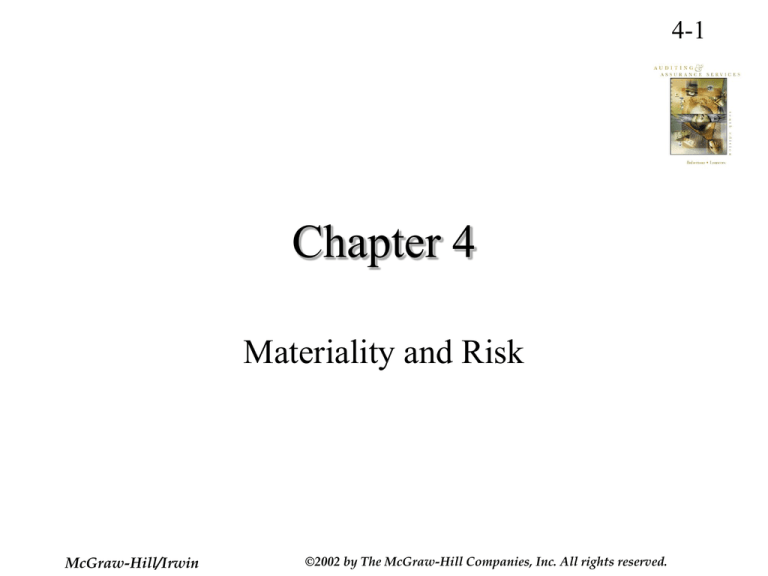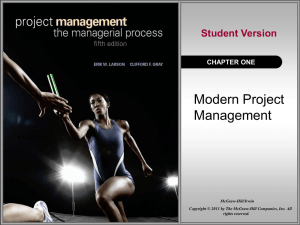
4-1
Chapter 4
Materiality and Risk
McGraw-Hill/Irwin
©2002 by The McGraw-Hill Companies, Inc. All rights reserved.
4-2
Audit Planning Tools
• Preliminary
materiality decisions
• Preliminary risk
assessment
• Audit programs
McGraw-Hill/Irwin
©2002 by The McGraw-Hill Companies, Inc. All rights reserved.
4-3
Materiality
• Materiality refers to an amount
(or transaction) that would
influence the decisions of users
with respect to the client's
financial statements, i.e., an
amount (or event) that would
make a difference.
McGraw-Hill/Irwin
©2002 by The McGraw-Hill Companies, Inc. All rights reserved.
4-4
Materiality Judgment Criteria
•
•
•
•
•
•
Absolute size
Relative size
Nature of the item or issue
Circumstances
Uncertainty
Cumulative Effects
McGraw-Hill/Irwin
©2002 by The McGraw-Hill Companies, Inc. All rights reserved.
4-5
AUDIT RISK MODEL
(ARM)
The AUDIT RISK MODEL decomposes
overall audit risk (AR) into three
components: inherent risk (IR),
control risk (CR), and detection risk
(DR).
AR = IR x CR x DR
McGraw-Hill/Irwin
©2002 by The McGraw-Hill Companies, Inc. All rights reserved.
4-6
Audit Risk Model
• AR = risk that the auditor may unknowingly fail
to modify the opinion on financial statements that
are materially misstated.
• IR = likelihood that, in the absence of internal
controls, a material misstatement could occur.
• CR = likelihood that a material misstatement
would not be caught by internal controls.
• DR = risk that a material misstatement would not
be caught by audit procedures.
McGraw-Hill/Irwin
©2002 by The McGraw-Hill Companies, Inc. All rights reserved.
4-7
Inherent Risk:
General Categories and Examples of Errors and Frauds
(Exhibit 4-2)
•
Invalid transactions are recorded: Fictitious sales are recorded and charged to
nonexistent customers.
•
Valid transactions are omitted from the accounts: Shipments to customers
never get recorded.
•
Unauthorized transactions are executed and recorded: A customer’s order is
not approved for credit, yet the goods are shipped, billed, and charged to the
customer without requiring payment in advance.
•
Transaction amounts are inaccurate: A customer is billed and the sale is
recorded in the wrong amount because the quantity shipped and the quantity billed
is not the same and the unit price is for a different product.
•
Transactions are classified in the wrong accounts: Sales to a subsidiary
company are recorded as sales to outsiders instead of intercompany sales, or the
amount is charged to the wrong customer account receivable record.
•
Transaction accounting and posting is incorrect: Sales are posted in total to
the accounts receivable control account, but some are not posted to individual
customer account records.
•
Transactions are recorded in the wrong period: Shipments made in January
(next year) are backdated and recorded as sales and charges to customers in
December. Shipments in December are recorded as sales and charges to
customers in January. ©2002 by The McGraw-Hill Companies, Inc. All rights reserved.
McGraw-Hill/Irwin
4-8
Factors Affecting Inherent Risk
•
•
•
•
Dollar size of the account
Liquidity
Volume of transactions
Complexity of the
transactions
• Subjectivity of estimates
McGraw-Hill/Irwin
©2002 by The McGraw-Hill Companies, Inc. All rights reserved.
4-9
Factors Affecting Control Risk
• Control environment
• Existence and effectiveness of control
activities
• Monitoring
McGraw-Hill/Irwin
©2002 by The McGraw-Hill Companies, Inc. All rights reserved.
4-10
Factors Affecting Detection Risk
• Nature, timing, and extent of audit
procedures
• Sampling risk
– Risk of choosing an unrepresentative sample
• Nonsampling risk
– Risk that the auditor may reach inappropriate
conclusions based upon available evidence.
McGraw-Hill/Irwin
©2002 by The McGraw-Hill Companies, Inc. All rights reserved.
4-11
Audit Program
• List of audit
procedures to be
performed
• Based upon output of
Audit Risk Model
McGraw-Hill/Irwin
©2002 by The McGraw-Hill Companies, Inc. All rights reserved.
4-12
GENERAL APPROACHES TO
GATHERING EVIDENCE
• Test of Transactions
– Few number of transactions
– High dollar value
• Test of Balances
– Large number of transactions
– Relatively smaller dollar value
– Auditor must be able to rely on internal
controls.
McGraw-Hill/Irwin
©2002 by The McGraw-Hill Companies, Inc. All rights reserved.
4-13
General Audit Procedures
•
•
•
•
•
Recalculation
Physical observation
Confirmation
Verbal Inquiry
Examination of documents
– Vouching
– Tracing
• Scanning
• Analytical Procedures
McGraw-Hill/Irwin
©2002 by The McGraw-Hill Companies, Inc. All rights reserved.
4-14
Auditing with Computers
• Automated Workpaper
Software
• Spreadsheet Software
• Text Retrieval Software
• Public Databases
• Word Processing Software
• Computer Assisted Audit
Tools and Techniques
(CAATTs)
McGraw-Hill/Irwin
©2002 by The McGraw-Hill Companies, Inc. All rights reserved.
4-15
Automated Workpaper
Software: Uses
• Budget/time and expense
analysis
• Trial balance generation
• Lead schedule generation
• Supporting detail schedules
• Adjusting entries
• Sampling calculations
• Confirmation control
• Consolidation
• Financial statement preparation
• Tax return preparation
McGraw-Hill/Irwin
©2002 by The McGraw-Hill Companies, Inc. All rights reserved.
4-16
Automated Workpaper
Software: Benefits
• Ease of use
• Enhanced engagement planning,
administration, and review
• Improved workpaper consistency
• Improved staff productivity
McGraw-Hill/Irwin
©2002 by The McGraw-Hill Companies, Inc. All rights reserved.
4-17
Spreadsheet Applications:
Uses
•
•
•
•
•
•
•
•
•
•
•
McGraw-Hill/Irwin
Analytic procedures
Mathematical procedures
Macros
Templates
Linked spreadsheets
Data import/export
Graphs
Database capabilities
Workpaper automation
Financial statement automation
Engagement administration
©2002 by The McGraw-Hill Companies, Inc. All rights reserved.
4-18
Spreadsheet Software
Advantages
• Ease of use
• Inexpensive
• Flexible
• Standard templates
can be developed
McGraw-Hill/Irwin
Disadvantages
• Training
• Development takes
time
• Computer memory
limitations
©2002 by The McGraw-Hill Companies, Inc. All rights reserved.
4-19
Text Retrieval Software
Advantages
• Easy to search large
volumes of
information
• Large volume of
information is
available
• Minimal training
necessary
McGraw-Hill/Irwin
Disadvantages
• Prohibitive start-up
costs
• Not all information is
available in electronic
format
• Some text files may
require modification
for ease of use
©2002 by The McGraw-Hill Companies, Inc. All rights reserved.
4-20
Public Databases
• Public databases are sources of information
available to the auditor via telephone link to
the auditor’s computer.
• Examples:
– LEXUS/NEXUS
– EDGAR
– Firm bulletin boards (Intranets)
McGraw-Hill/Irwin
©2002 by The McGraw-Hill Companies, Inc. All rights reserved.
4-21
Word Processing Software:
Uses
• Consideration of the
client’s internal
controls
– Documenting
understanding
– Internal control
questionnaires
• Developing audit
programs
• Reporting
McGraw-Hill/Irwin
©2002 by The McGraw-Hill Companies, Inc. All rights reserved.
4-22
Word Processing Applications
Advantages
• Error correction
• Reusable manuscripts
• Mail merge
• Flexibility to import
graphs and
spreadsheets
McGraw-Hill/Irwin
Disadvantages
• Training costs
©2002 by The McGraw-Hill Companies, Inc. All rights reserved.
4-23
Computer Assisted Audit Tools and
Techniques (CAATTs)
• CAATTs - the use of software to perform audit procedures
• With CAATTS, the auditor is able to access and extract client
information without disrupting data processing
• Some CAATTs Procedures
– Calculate field statistics (totals, high, low and average value)
– Performing complex recalculations
– Join, concantenate and compare different files
– Perform detailed analysis
• Stratification
• Gap and duplicate key detection
• Sample selection
McGraw-Hill/Irwin
©2002 by The McGraw-Hill Companies, Inc. All rights reserved.





